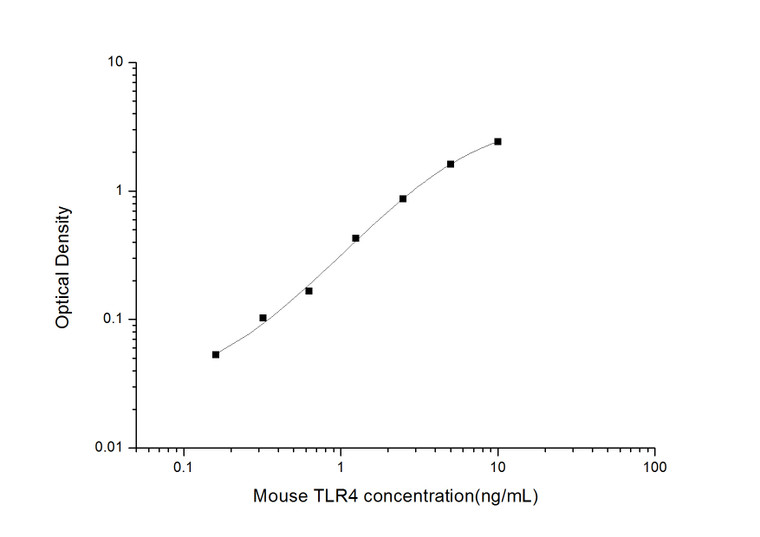| Applications: |
ELISA |
| Reactivity: |
Mouse |
| Note: |
FOR SCIENTIFIC EDUCATIONAL RESEARCH USE ONLY (RUO). MUST NOT BE USED IN DIAGNOSTIC OR OTHER MEDICAL APPLICATIONS. |
| Sensitivity: |
0.09ng/mL |
| Detection Limit: |
0.16~10ng/mL |
| Short Description: |
This Tlr4 Sandwich ELISA is an in-vitro enzyme-linked immunosorbent assay for the measurement of samples in mouse cell culture supernatant, serum and plasma (EDTA, citrate, heparin). |
| Storage Instruction: |
If unopened the kit may be stored at 2-8°C for up to 1 month. If the kit will not be used within 1 month, store the components separately, according to the component table in the manual. |
| Assay Time: |
3.5h |
| Detection: |
Colormetric |
| Gene Symbol: |
Tlr4 |
| Gene ID: |
21898 |
| Uniprot ID: |
TLR4_MOUSE |
| Specificity: |
This kit recognizes Mouse TLR4 in samples. No significant cross-reactivity or interference between Mouse TLR4 and analogues was observed. |
| Sample Type: |
Serum, plasma and other biological fluids |
| Post Translational Modifications | Phosphorylated on tyrosine residues by LYN after binding lipopolysaccharide. |
| Function | Transmembrane receptor that functions as a pattern recognition receptor recognizing pathogen- and damage-associated molecular patterns (PAMPs and DAMPs) to induce innate immune responses via downstream signaling pathways. At the plasma membrane, cooperates with LY96 to mediate the innate immune response to bacterial lipopolysaccharide (LPS). Also involved in LPS-independent inflammatory responses triggered by free fatty acids, such as palmitate, and Ni(2+). Mechanistically, acts via MYD88, TIRAP and TRAF6, leading to NF-kappa-B activation, cytokine secretion and the inflammatory response. Alternatively, CD14-mediated TLR4 internalization via endocytosis is associated with the initiation of a MYD88-independent signaling via the TICAM1-TBK1-IRF3 axis leading to type I interferon production. In addition to the secretion of proinflammatory cytokines, initiates the activation of NLRP3 inflammasome and formation of a positive feedback loop between autophagy and NF-kappa-B signaling cascade. In complex with TLR6, promotes inflammation in monocytes/macrophages by associating with TLR6 and the receptor CD86. Upon ligand binding, such as oxLDL or amyloid-beta 42, the TLR4:TLR6 complex is internalized and triggers inflammatory response, leading to NF-kappa-B-dependent production of CXCL1, CXCL2 and CCL9 cytokines, via MYD88 signaling pathway, and CCL5 cytokine, via TICAM1 signaling pathway. In myeloid dendritic cells, vesicular stomatitis virus glycoprotein G but not LPS promotes the activation of IRF7, leading to type I IFN production in a CD14-dependent manner. (Microbial infection) Required for the virulence of fungus C.neoformans var. grubii serotype A (strain KN99) CPL1. Independently of Ly96/Md2, activated by CPL1 which results in a type 2 inflammation response characterized by Arg1/arginase-1 induction in interstitial macrophages. |
| Protein Name | Toll-Like Receptor 4Cd Antigen Cd284 |
| Database Links | Reactome: R-MMU-140534Reactome: -MMU-166016Reactome: -MMU-166166Reactome: -MMU-2562578Reactome: -MMU-5686938Reactome: -MMU-936964Reactome: -MMU-937041Reactome: -MMU-937072Reactome: -MMU-9707616Reactome: -MMU-975163 |
| Cellular Localisation | Cell MembraneSingle-Pass Type I Membrane ProteinEarly EndosomeCell ProjectionRuffleUpon Complex Formation With Cd36 And Tlr6Internalized Through Dynamin-Dependent EndocytosisColocalizes With Rftn1 At Cell Membrane And Then Together With Rftn1 Moves To EndosomesUpon Lipopolysaccharide Stimulation(Microbial Infection) Endocytosed Upon Interaction With Fungus CNeoformans VarGrubii Serotype A (Strain Kn99) Cpl1 At The Macrophage Cell Surface |
| Alternative ELISA Names | Toll-Like Receptor 4 ELISA kitCd Antigen Cd284 ELISA kitTlr4 ELISA kitLps ELISA kit |
| Specificity | This kit recognizes Mouse TLR4 in samples. No significant cross-reactivity or interference between Mouse TLR4 and analogues was observed. |
| Reproducibility | Both intra-CV and inter-CV are |
Information sourced from Uniprot.org
| Item | Specifications | Storage |
| Micro ELISA Plate (Dismountable) | 96T: 8 wells ×12 strips strips | -20℃, 6 months |
| Reference Standard | 96T: 2 vials 48T: 1 vial | -20℃, 6 months |
| Concentrated Biotinylated Detection Ab (100×) | 96T: 1 vial, 120 μL 60 μL | -20℃, 6 months |
| Concentrated HRP Conjugate (100×) | 96T: 1 vial, 120 μL 60 μL | -20℃ (Protect from light), 6 months |
| Reference Standard & Sample Diluent | 1 vial, 20 mL | 2-8°C, 6 months |
| Biotinylated Detection Ab Diluent | 1 vial, 14 mL | 2-8°C, 6 months |
| HRP Conjugate Diluent | 1 vial, 14 mL | 2-8°C, 6 months |
| Concentrated Wash Buffer (25×) | 1 vial, 30 mL | 2-8°C, 6 months |
| Substrate Reagent | 1 vial, 10 mL | 2-8℃ (Protect from light) |
| Stop Solution | 1 vial, 10 mL | 2-8°C |
| Plate Sealer | 5 pieces | |
| Manual | 1 copy | |
| Certificate of Analysis | 1 copy | |
| Sample Type | Range (%) | Average Recovery (%) |
| Serum(n=8) | 90-103 | 97 |
| EDTA plasma (n=8) | 88-104 | 95 |
| Cell culture media (n=8) | 91-108 | 99 |
| | Intra-assay Precision | Intra-assay Precision | Intra-assay Precision | Inter-assay Precision | Inter-assay Precision | Inter-assay Precision |
| Sample | 1.00 | 2.00 | 3.00 | 1.00 | 2.00 | 3.00 |
| n | 20.00 | 20.00 | 20.00 | 20.00 | 20.00 | 20.00 |
| Mean (ng/mL) | 0.46 | 1.40 | 3.66 | 0.50 | 1.33 | 3.57 |
| Standard deviation | 0.03 | 0.07 | 0.20 | 0.03 | 0.08 | 0.13 |
| CV (%) | 6.52 | 5.00 | 5.46 | 6.00 | 6.02 | 3.64 |
12 months for antibodies. 6 months for ELISA Kits. Please see website T&Cs for further guidance







